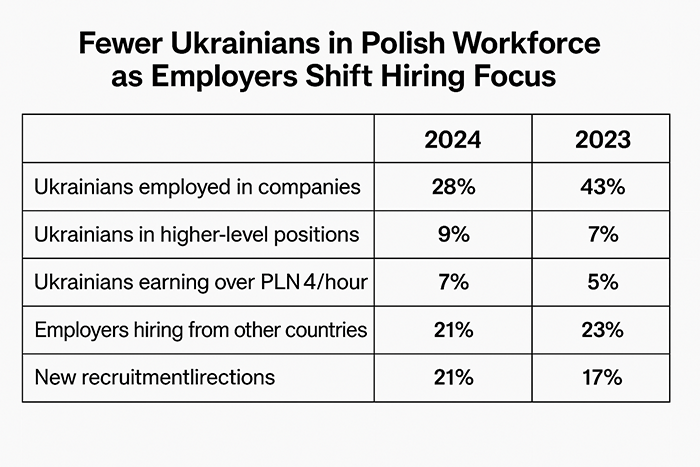Fewer Ukrainians in Polish workforce as employers shift hiring focus
The number of Ukrainian workers employed in Polish companies has declined over the past year, according to the latest Polish Labour Market Barometer by Personnel Service. Currently, Ukrainians are employed in 28% of companies across Poland, compared to 43% a year earlier—a drop of 15 percentage points. Large enterprises remain the most reliant on this workforce, employing Ukrainians in 46% of cases, while medium-sized companies report 32%, and small businesses just 6%.
The shift is also reflected in data from the Social Insurance Institution (ZUS). Before the Russian invasion of Ukraine, Ukrainians made up 74% of all employed foreigners in Poland. By the end of November 2024, their share had declined to 66%. Over the past year, the number of insured foreign workers in Poland rose by 64,500, but only 13,400 of these were Ukrainians. In contrast, Belarusians recorded the largest increase, with 22,300 more people entering the workforce.
Despite this drop, demand for workers remains high, with over 100,000 job vacancies still open across the Polish labour market. However, employers are increasingly cautious. Many anticipate either a worsening economic climate or stagnation, which has made them hesitant to expand their workforce. This cautious approach applies equally to hiring both Polish nationals and foreign workers.
Krzysztof Inglot, labour market expert and founder of Personnel Service, explains that Ukrainians continue to be the first choice for many companies when seeking foreign labour. But when these candidates are unavailable, businesses are becoming more open to workers from other countries.
Ukrainians in the Polish workforce still predominantly occupy lower-level roles, with 45% of companies reporting employment in these positions. However, there has been a noticeable shift in the employment structure: the proportion of Ukrainians in mid-level positions has grown by 18 percentage points and now stands at 40%. A smaller share, 9%, are in higher-level roles.
In terms of pay, most Ukrainian workers continue to earn close to the minimum wage. Around 41% of companies offer wages in the range of PLN 30.5 to 34.9 gross per hour. Another 20% pay between PLN 35 and 39.9 gross per hour, while only 7% of employers offer rates above PLN 40.
The changing composition of the workforce is prompting employers to look beyond Ukraine. According to the survey, 21% of businesses expressed interest in hiring from countries other than Ukraine. Belarusian workers remain the most sought-after after Ukrainians, but there is also growing openness to labour from Asia. Approximately 36% of companies are considering candidates from India, Nepal, the Philippines, or Bangladesh.
ZUS data supports this trend. As of November 2024, 1.2 million foreign workers were registered in Poland’s social insurance system. Following Ukrainians, the largest groups were Belarusians (135,600) and Georgians (26,500). The number of Asian workers is also rising, with 22,600 Indian citizens, 14,600 Filipinos, 10,500 Vietnamese, and 9,300 Nepalese now employed in Poland.
The data was collected via a national online survey conducted between 20 and 28 January 2025 using the CAWI method. The employer sample included 329 companies of varying sizes—small (up to 10 employees), medium (10–49), and large (50–249).
Source: Personal Service









